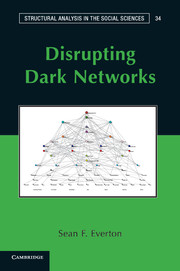Book contents
- Frontmatter
- Contents
- Figures
- Tables
- Preface
- Acknowledgments
- Part I Introduction
- Part II Social Network Analysis: Techniques
- Part III Social Network Analysis: Metrics
- 5 Network Topography
- 6 Cohesion and Clustering
- 7 Centrality, Power, and Prestige
- 8 Brokers, Bridges, and Structural Holes
- 9 Positions, Roles, and Blockmodels
- Part IV Social Network Analysis: Advances
- Part V Conclusion
- Appendix 1 The Noordin Top Terrorist Network
- Appendix 2 Glossary of Terms
- Appendix 3 Multidimensional Scaling with UCINET
- Appendix 4 The Just War Tradition
- References
- Index
5 - Network Topography
Published online by Cambridge University Press: 05 April 2013
- Frontmatter
- Contents
- Figures
- Tables
- Preface
- Acknowledgments
- Part I Introduction
- Part II Social Network Analysis: Techniques
- Part III Social Network Analysis: Metrics
- 5 Network Topography
- 6 Cohesion and Clustering
- 7 Centrality, Power, and Prestige
- 8 Brokers, Bridges, and Structural Holes
- 9 Positions, Roles, and Blockmodels
- Part IV Social Network Analysis: Advances
- Part V Conclusion
- Appendix 1 The Noordin Top Terrorist Network
- Appendix 2 Glossary of Terms
- Appendix 3 Multidimensional Scaling with UCINET
- Appendix 4 The Just War Tradition
- References
- Index
Summary
Introduction
As noted in the second chapter, although social network analysis appears to have wide appeal as a methodological tool for targeting members of dark networks (see, e.g., Gjelten 2010), it can be applied far more broadly than it has been thus far. Furthermore, strategy should drive the choice of metrics rather than the other way around. Unfortunately, just the opposite often occurs. The tail (i.e., the choice of metrics) is often found wagging the dog (i.e., the strategic choices) rather than the other way around. Indeed, the most common application of SNA to the study of dark networks has focused on targeting central actors within the network for elimination or capture (aka the “whack a mole” strategy). Although this focus is intuitively appealing and can provide short-term results, it may be misplaced and, in fact, make tracking, disrupting, and destabilizing terrorist networks more difficult. As Brafman and Beckstrom (2006) have noted, targeting key players in decentralized organizations seldom shuts them down. Instead, it only drives them to become more decentralized, making them harder to target. In terms of terrorist networks, such a strategy may in fact exacerbate what Sageman (2008) refers to as the “leaderless jihad,” by which he means the numerous independent and local groups that have branded themselves with the Al Qaeda name and are attempting to emulate bin Laden and his followers by conceiving and executing terrorist operations from the bottom up.
This chapter argues that analysts need to first explore a terrorist network's overall topography (i.e., its level of density, centralization, degree of fragmentation, etc.) before identifying subgroups and estimating centrality, brokerage, and other types of metrics. This is not to say analysts have completely neglected the topographical dimensions of terrorist networks. There have been exceptions. Pedahzur and Perliger (2006), for example, noted that terrorist networks with a large number of cliques (see Chapter 6) appear to be more effective than those with few, and the most recent U.S. Army and Marine counterinsurgency manual (U.S. Army 2007) argues that network density is positively associated with network efficiency and, as such, should guide tactics. Perhaps the best-known example is Sageman's (2004) initial study of what he calls the global Salafi jihad (GSJ) in which he found that it exhibits the characteristics of a scale-free network.
- Type
- Chapter
- Information
- Disrupting Dark Networks , pp. 135 - 169Publisher: Cambridge University PressPrint publication year: 2012



